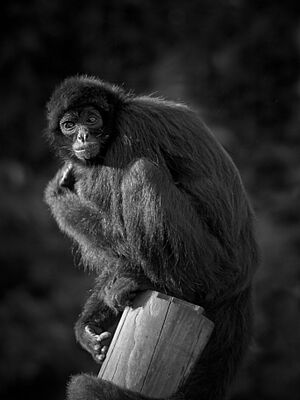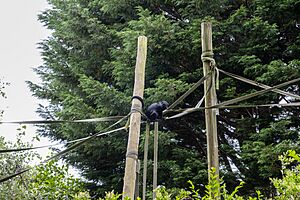Colombian spider monkey facts for kids
Quick facts for kids Colombian spider monkey |
|
|---|---|
 |
|
| Conservation status | |
| Scientific classification |
|
| Kingdom: | Animalia |
| Phylum: | Chordata |
| Class: | Mammalia |
| Order: | Primates |
| Suborder: | Haplorhini |
| Infraorder: | Simiiformes |
| Family: | Atelidae |
| Genus: | Ateles |
| Species: | |
| Subspecies: |
A. f. rufiventris
|
| Trinomial name | |
| Ateles fusciceps rufiventris (Sclater, 1872)
|
|
| Synonyms | |
|
|
The Colombian spider monkey (Ateles fusciceps rufiventris) is a special type of New World monkey. It is a subspecies of the Black-headed spider monkey. You can find these monkeys in Colombia and Panama. Some scientists think it's actually a subspecies of Geoffroy's spider monkey.
Contents
About the Colombian Spider Monkey
Where Do They Live?
Colombian spider monkeys live in different kinds of forests. These include dry forests, humid forests, and even cloud forests. They can live high up in the mountains, sometimes as high as 2,000 to 2,500 metres (6,600 to 8,200 ft) above sea level.
What Do They Look Like?
This monkey is mostly black. It has a little bit of white fur on its chin. Its body is black, and it has very long limbs. Unlike many monkeys, its hands do not have thumbs.
The Colombian spider monkey has a very special tail. It's called a prehensile tail, which means it can grab things. It's also super flexible, acting like an extra arm or leg! The tip of the tail has a patch of skin with no hair. This patch helps the monkey grip branches. Each monkey's tail patch has unique markings, just like a human fingerprint.
These monkeys can weigh up to 9.1 kilograms (about 20 pounds).
What Do They Eat?
Colombian spider monkeys love fruit! About 80 percent of their diet is fruit. They also eat other things like leaves, nuts, seeds, tree bark, insects, and flowers. When they eat fruit, they help spread the seeds around the forest. This helps new plants grow.
How Long Do They Live?
A Colombian spider monkey can live for about 24 years.
Spider Monkey Behavior
Social Life
Spider monkeys live in social groups. These groups can have up to 30 monkeys. However, they usually split into smaller groups of 3 or 4 to find food. This way, there's enough food for everyone.
Moving Through the Trees
Spider monkeys are amazing climbers. They move through the forest by swinging from branch to branch. This way of moving is called brachiation. They use their long arms and strong grip to swing easily through the trees.



